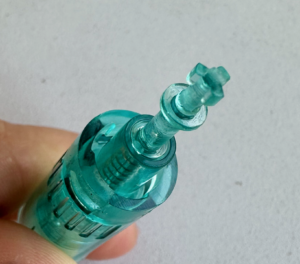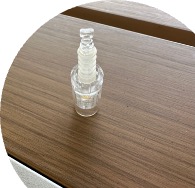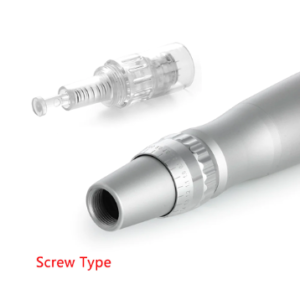By Michelle Gellis AP LAc MAc DiplAc
Microneedling is a cosmetic treatment growing in popularity amongst acupuncturists. It involves puncturing the skin with tiny needles to stimulate collagen production and rejuvenate the skin. It’s a safe and effective procedure that can be performed using a variety of microneedling devices. With so many options available, it can be challenging to choose the right one to meet the needs of your practice. In my previous article I discussed the relationship between microneedling and Chinese medicine. In this article, I will discuss how to choose a device that is safe and effective for your practice.
First and foremost is manufacturing materials. Is the pen made of plastic? Aluminum? Other metals? Plastic is porous and will not hold up to professional daily use. Other metals such as steel and aluminum are good choices. Aluminum is lighter which is important if you are holding the pen for long periods of time. Additionally look at the size of the pen. Will it be easy to grip and manipulate around your patients face and neck. How does it feel in your hand?
Microneedle pen speed.
Microneedle pen speeds vary. The pen you chose should have a speed of at least 14,000RPM, ideally 18,000RPM. This an important parameter as it determines the speed at which the needles will move up and down to penetrate the skin. The faster the RPMs the more punctures the pen will make as it passes over the skin. Higher RPMs also reduce drag and potential for injury. Pen speeds should be adjustable and easy to identify. Slower speeds are useful for certain conditions. Higher RPM values potentially reduce treatment time while lower RPM values may offer more precise control for delicate areas or sensitive skin.
Microneedle Depth
. The needles on your pen should be adjustable from 0mm to at least 2.0mm. The adjustment ring should be easy to move and the numbers easy to read even when there is a sleeve on the pen. The adjustment ring shouldn’t be in the way of your fingers when you are holding the pen so that you don’t accidentally change the depth while using the pen.
Microneedle Cartridges
The cartridges that pair with the pen are an important part of the device as well. Most important is how the tip locks into the pen. The more connection points the tip has, the less likely it is to vibrate loose off the pen. Additionally, a tighter, more secure connection reduces the possibility of fluid leaking back into the pen. A “bayonet style locking system allows for a safer and easier operation of the needling pen, while maintaining a sturdier connection to device. The more tightly the cartridge is connected device the less chance there is for slippage, cartridges disconnecting and more stable needling without dragging. There are double bayonet style and triple bayonet, I prefer the triple for more connection points.



Needle Cartridges for the pens range from 9-64 pins. The fewer needles in the cartridge, the deeper they will penetrate the skin. If there is a higher number of needles they won’t go as deep. I prefer a 16-pin cartridge but chose one that works best for your clinic’s needs.
Here are some general parameters for needles:
- Low needle count: Some microneedle pen cartridges have a lower number of needles typically ranging from 9 to 12 needles. These cartridges are often used for targeted treatments or for sensitive areas where precision is crucial.
- Medium needle count: Microneedle pen cartridges with a medium needle count usually contain around 12 to 36 needles. These cartridges are suitable for general facial treatment and can provide effective coverage over larger treatment areas.
- High needle count: Microneedle pen cartridges with a higher needle count can range from approximately 36 to 64 needles or more these cartridges are often used for body treatments desired the higher the needle count can cover larger areas more efficiently.
Needle diameter & material. The thinner the needles, the less trauma to the skin. Look for needles that have a diameter of .18mm rather than .25mm (which is more common). Stainless steel coated with titanium is the preferred material for needles as they will not rust due to moisture or humidity if exposed. Since some individuals are allergic to stainless steel, the titanium provides strength and protects against allergies.
Nanoneedles.
Nanoneedling is much less invasive than microneedle cartirdges and allows up to 97% product absorption. Nanoneedling doesn’t require any numbing cream and has zero downtime. Nanoneedle cartridges come in either round or square shapes. Nano needles are 110μm and only penetrate the stratum corneum. I prefer square needles made of stainless steel and tipped with a thin layer of silicone.
Round versus square nanoneedle cartridges
Round cartridges:
- Gentle Stimulation: Round nano needles typically provide a milder form of stimulation to the skin due to their smooth, rounded edges. They are ideal for clients with sensitive or delicate skin.
- Even Distribution: The round shape allows for a more uniform distribution of pressure during the microneedling process, reducing the chances of causing uneven punctures or microtears in the skin.
- Versatility: Round nano needles can be used for a variety of skincare concerns, such as improving overall skin texture, promoting collagen production, and enhancing the absorption of skincare products.
Square Nano Needle:
- Targeted Treatment: Square nanoneedles have sharper edges, which make them suitable for targeting specific skin concerns, such as acne scars, fine lines, or hyperpigmentation. The square shape allows for precise application and more targeted stimulation.
- Enhanced Penetration: The square edges of the needles can create microchannels that penetrate deeper into the skin compared to round needles. This can be beneficial for clients looking to address deeper skin imperfections.
- Customization: Square nanoneedle tips often come in different configurations, such as different needle lengths or arrangements, allowing for more customization based on individual client needs and desired outcomes.
Ultimately, the choice between round and square nano needle tips depends on the client’s skin condition, sensitivity, and the specific goals of the treatment. It is important to consider factors such as skin type, desired results, and the recommendations provided by the manufacturer or supplier of the microneedling equipment.
Battery Life.
The battery life of the microneedle pen can depend on several factors including the usage patterns and settings generally pans are equipped with. Rechargeable lithium-ion batteries are typical for microneedle pens
With regular usage the battery of a microneedle pen should last anywhere from one to three hours before requiring a recharge with continual use. If you use the microneedle pen intermittently such as for shorter sessions or occasional treatments the battery should last longer potentially up to several days or even weeks depending on the frequency and duration of use.
To ensure uninterrupted usage it’s recommended to charge your microneedle pen fully before each treatment session especially if you anticipate a longer treatment time This is why is it important to purchase a pen which has two rechargeable batteries and a cord in case neither battery is charged it’s always a good practice to follow the manufacturers guidelines regarding charging and battery maintenance to maximize the lifespan and duration of the device. Note the following estimates are approximate and can vary depending on usage higher speed or power settings may consume the battery faster compared to lower settings.
Case.
Having a storage case is not a necessity, but it is useful to maintain your investment by storing it in a custom metal case which will allow for ease of transportation, protection, cleanliness, and storage.
Warranty.
When choosing a pen system, look for one that provides a full replacement warranty. Since pen parts cannot repaired, any pen you purchase should come with a full replacement policy on the party and the pen.
Serums.
There are many options for products to use when microneedling. The product of choice in most instances is hyaluronic acid. It must be the first ingredient listed and should provide adequate “slip” to avoid the needles dragging on the skin. Most important is the safety and hypoallergic nature of the products.
When looking for products these are the important things to know:
- Are the ingredients organic?
- Are the ingredients vegan?
- Does the manufacturer list the ingredients on the bottle?
- Is it shelf stable up to one year?
- What other ingredients are included? Ingredients like vitamin C and hyaluronic acid are key for microneedling. Among vitamin C options magnesium ascorbyl phosphate (MAP) and sodium ascorbyl phosphate are more stable and less likely to cause skin irritation compared to pure ascorbic acid. They are also effective in brightening the skin and promoting collagen synthesis.
- Avoid ingredients such as copper which can irritate the skin and cause granulomas which are an uncommon but possible side effect in those who are allergic to copper.
- Whatever product line you choose should include and aftercare serum which allows your patient to care for their skin and soothe any irritation after they have left your office.
- Consider the manufacturer and where the ingredients are coming from. Are they made in a lab or in small batches? Who has formulated them? Are they produced in the US or overseas?
Settings.
Settings on a microneedle pen should be easy to read. Typically, there are two settings that need to be distinguished. The first is the speed of the pen. I prefer a pen with a large LED display which is easy to read so there is no question what speed I’m using when I am working. The second is the adjustment ring which determines the depth of the needles when needling. The adjustment ring numbers should be easy to read even if you have a protective sleeve over the pen. The numbers should be large and in a different color than the pen itself. Also, the arrow pointing to the numbers should be obvious as well.
Versatility-Cord-Battery.
Versatility in power sources is important, especially if you are running a busy practice. I prefer the convenience of a battery plus a backup. On the outside chance that both batteries are being charged, a long cord attachment can be a lifesaver in a busy practice as well.
Support.
Microneedle pens require training and support. Live, livestream or recorded training which includes continuing education credits benefits you and your practice. Your investment in a pen system must provide for marketing materials: a page for your website, brochures, before and after photos, blog posts, take home instructions for your patients.
In summary:
Choosing the right microneedling device for a practice requires careful consideration of various factors. The device should be made of durable materials, offer adjustable speed and needle depth, and have a secure cartridge connection. Needle count, diameter, and material should align with the treatment goals and client’s skin type. Nanoneedling options should be evaluated based on the desired level of stimulation and penetration. Battery life, warranty, and the availability of a storage case are also important.
Serums used during microneedling should be safe, hypoallergenic, and include beneficial ingredients like hyaluronic acid and stable forms of vitamin C. The manufacturer’s reputation and ingredient sourcing should be assessed. Clear settings and versatile power sources enhance usability. Training, marketing materials, and customer support are crucial for success in incorporating microneedling into a practice. By considering these factors, practitioners can choose a microneedling device that is safe, effective, and meets their specific needs.

